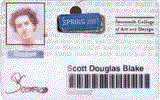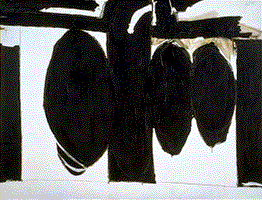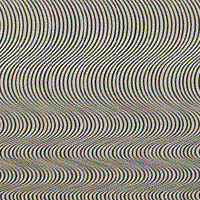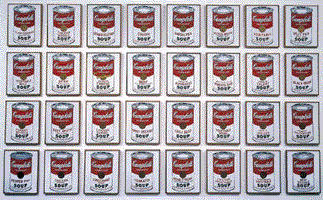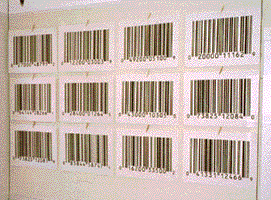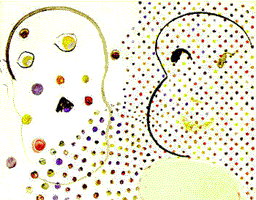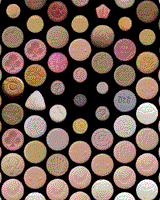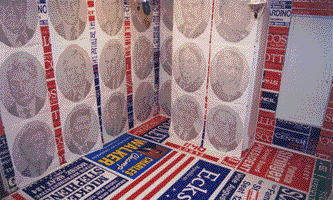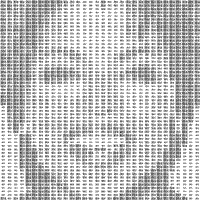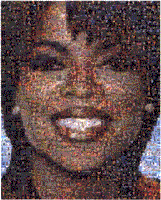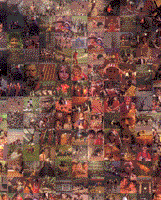
Licensed Under
Creative Commons
| Abrstraction, "Capitalist Realist", and the system by Alessandro Imperato |
|||||||||||||||||||||||||||||||||||||||||||||||||||||||||||||||||||||||
| Alessandro Imperato – How does your work use abstraction to represent the ‘real’?
Scott Blake – Bar codes are full of abstractions that represent ‘real’ things. The bar code on my SCAD ID represents me. SCAD first abstracted me into a number. The number is abstracted further into a series of black and white lines. And finally the lines are an abstract representation of binary code. I = Scott Douglas Blake Scott Douglas Blake = 000035922 000035922 = BWBWWWBBWBWWBBWWBWWBWWBBWWWBBWBWWWBBWBWWWBBWBWBW BWBBBWWBWBBBWWBWBBWBBWWBWWWWWBWBBBWWBWBWBBBWWBWB BWBWWWBBWBWWBBWWBWWBWWBBWWWBBWBWWWBBWBWWWBBWBWBW BWBBBWWBWBBBWWBWBBWBBWWBWWWWWBWBBBWWBWBWBBBWWBWB = 010111001011001101101100111001011100101110010101 010001101000110100100110111110100011010100011010 therefore I = 010111001011001101101100111001011100101110010101 010001101000110100100110111110100011010100011010 I have a hard time writing about the connection between my bar code and Paula Wallace, but that is what my portrait is all about. How do the producer and consumer relate, how the entertainer and the entertained interact, and how the leaders and the leaded work together.
When I stopped seeing bar codes as bar codes and began to think of them as art, a few abstract artists came to mind: Robert Motherwell, Ellsworth Kelly, and Bridget Riley. I was fascinated how Motherwell was able use just black and white paint to express his feelings about the Spanish Civil War in a completely non-objective manner. Kelly's ultra hard edges and absolutely smooth surfaces drew me to the aesthetic of mechanical production. I have been into optical illusions since I was a kid. I like how Bridget Riley’s static paintings appear to move and there is a certain quality that makes your head ache. Riley is another artist that does it with just and black and white paint.
Mark Napier recently made a piece called "black & white" which uses the current stream of zeros and ones from cnn.com to generate a complex abstract animation.
Andy Deck created a net.art piece that translates the entire works of Shakespeare into a stream of bar codes.
Several of my bar code pieces utilize random information to create abstract bitmap imagery. AI – Are you a ‘Capitalist Realist’ in the tradition of Andy Warhol, Yves Klein, and Sigmar Polke? SB - This was a real tough question because I never heard of a 'Capitalist Realist' until you asked me if I was one. Rather than bluffing it, I will tell you how I view myself in relation to those artists work. I felt a profound connection with Warhol the first time I saw his art. Warhol’s soup cans directly inspired my bar code painting series. A big difference is between these works is the production techniques. Warhol had his "Factory" where he directed other people to bang out screenprints like an art machine. I hand paint each bar code by myself in my lonesome studio. My paintings highlight the human touch in a mechanical world. Warhol's prints tried to strip away the individual artist. We both appropriated our content from popular culture. Warhol was actually the first artist to paint a bar code. I feel like I took my content from Warhol's art itself.
Below is a Sigmar Polke painting and digital self portrait I made with ecstasy pills. Some of the pills have corporate logos imprinted on them which reminds me of a Warhol drawing where he superimposed logos on a person's face. Another interesting link is that Polke and I choose to depict Lyndon Baines Johnson (LBJ) how was one of the US Presidents.
The halftone dot is represented larger than life. Polke, Lichtenstein, and I mimic mechanical reproduction techniques that is used to print mass media.
Gehard Richter’s 48 Portraits has a similar feel to my Pixel President which has 42 portraits. Both use multiple grayscale images of white stuffy guys in suits. All of eyes in Richter's piece are staring towards the center which creates a fixed focal point in the overall composition. All of my Presidents are looking around the room creating an active focal point that is elusive. AI – How do you prevent your work from colluding with the system or critiques? SB - I want my work to be critiqued, I want to be recognized by the mainstream, but I find the current system unacceptable and conversely it does not accept my art. I challenge the status quo and until some serious changes take place my work will not be discussed at large. A great example of the difference between my art and other art that is colluding with the system is my bar code portrait of Oprah and Rob Silvers Photomosaic of talk show host. We both actually used the same picture which makes this comparison even juicer. I portrayed her in black and white, which makes it less realistic and harder to see, but much more expressive than the full color Photomosaic. Silver's has written about the macro/micro relationship and is aware of this element in his art, but the link between Oprah's face and girls in Africa is weak and stinks of ass kissing. On the other hand my image uses bar codes that Oprah has endorsed, displayed on her show, and profits from there sale. I sent Oprah a 60 x 60 inch print over a year ago and never heard a thing. Rob Silvers artwork was unveiled and celebrated on Oprah's show. The system, status quo, and mainstream are all relative. Charlie Manson was asked what he would do if he ever got out of jail and he said, "I'm already out".
|
|||||||||||||||||||||||||||||||||||||||||||||||||||||||||||||||||||||||
|
|||||||||||||||||||||||||||||||||||||||||||||||||||||||||||||||||||||||
| Return To Publications | |||||||||||||||||||||||||||||||||||||||||||||||||||||||||||||||||||||||
